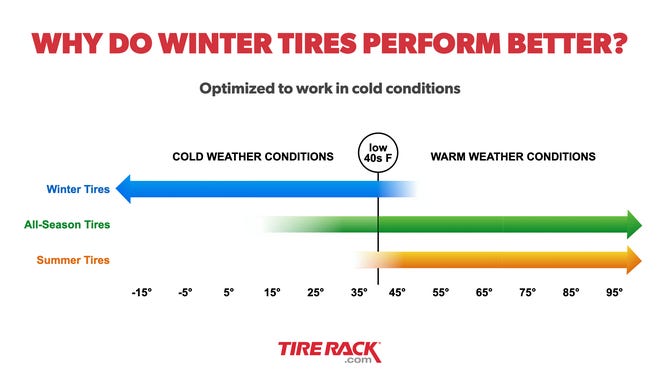Any day now, a few million drivers will make their vehicles safer in a way most Americans never consider — by switching to winter tires. It costs money, but less than most people expect, and the difference in steering, accelerating and braking is enough that drivers in many parts of the world wouldn’t consider trusting the same tires on a sunny, 90-degree Fahrenheit day and a damp, 40F one, much less in an actual winter storm.

“The difference a winter tire makes is almost unimaginable,” said TJ Campbell, tire information and testing manager for retailer the Tire Rack.
“There’s no comparison of braking distance. Not just on ice and snow, but also on wet, cold and slippery surfaces.”
Part of the difference is obvious: Winter tires, sometimes called snow tires, have different tread patterns. Like an iceberg, though, 90% of the substance is hidden under the surface. Winter tires are made of rubber compounds created to improve traction at low temperatures. The tread’s ability to grip snow or disperse water is almost beside the point.
Winter tires are mandatory in parts of Europe, recommended throughout Canada and required in Quebec.
If you can see your breath — you’re late
“They’re not just snow tires,” Campbell said. “Winter tires are better in all conditions below 40F.
“ ‘Snow tires’ is a very dated term. The tires also excel in subfreezing dry conditions, on ice, watery ice and slush.” The term ‘snow tire’ dates to before tire makers fully understood the chemistry of rubber, water and temperature. Until the 1990s or so, winter tires were distinguished primarily by deeper grooves and more aggressive tread patterns that dug into the surface of snow or ice for a better grip.
“I generally tell people to use winter tires from Thanksgiving to Tax Day” — April 15 — Campbell said. “If you can consistently see your breath, you should’ve changed your tires already.”

That’s particularly true if you have a performance car with summer tires. They provide phenomenal grip zipping around curves spring through fall, but steering and braking performance fall drastically with ambient temperature.
Modern winter tires are made of chemical compounds that stay flexible and grippy at lower temperatures than the so-called “all season” tires most people use year-round.
That puts tire makers in a weird position. All the major ones have some tires called “all season” or words to that effect, but they also know that no tire is at its best in the full range of temperatures seen much of the United States and nearly all of Europe. “Three-season” is more accurate, but tire makers are reluctant to hand the competition a selling tool with a name that suggests their product is less versatile. Welcome to capitalism.
Longer life for regular tires
Despite the benefits, only a fraction of U.S. drivers use winter tires. They only account for about 2.1% of replacement tire sales.
That’s partly because of the cost, partly because most people have no idea how much better they perform.

There’s no getting around the fact that two sets of tires and wheels cost more than one. However, using winter tires can extend the life of your primary set significantly.
The idea of three-season versus winter tires is also key to making using both more affordable: Using winter tires three or four months a year extends the life of your other tires.
A chart from tire rack shows that if you drive 13,500 miles a year, over the course of six years you’ll go through two sets of all-season tires or one set of all-season and one of winter tires. If that holds true, the cost increase comes down to the second set of wheels and changing the tires in spring and fall.
Less expensive than you might think
Contrary to popular belief, you won’t destroy winter tires using them on pleasant spring days. Campbell says drivers can use winter tires for a couple of weeks with temperatures in the 50s and 60s without shortening their useful life.
The price of winter tires varies widely depending on vehicle, tire brand and more. Prices can start as low as $90 a tire for an economy car and reach $240 or more for a luxury vehicle.

Its also a good idea to get a set of inexpensive winter wheels. They may be steel or alloy. Prices range from under $100 to $250 apiece, depending on size, material and design.
Experts recommend getting tires one size smaller — that is, narrower — than your three-season tires. The slimmer footprint and taller sidewalls reduce resistance from water and slush.
The winter wheels are insurance against corrosion and damage for your more expensive three-season wheels. Keeping the tires on wheels year-round also reduce time and cost when you change tires with the seasons. Local tire retailers will swap the tires, and Tire Rack installers will do it in your driveway for $30 a wheel.
Contact Mark Phelan:mmphelan@freepress.com. Follow him on Twitter @mark_phelan. Read more on autos and sign up for our autos newsletter. Become a subscriber.